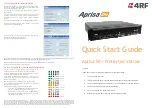
PRIMUS
R
660 Digital Weather Radar System
A28–1146–111
REV 2
Federal Aviation Administration (FAA) Advisory Circulars
A–10
D
If using airborne radar, tilt the antenna up and down occasionally.
This will permit you to detect other thunderstorm activity at altitudes
other than the one being flown.
Following are some do’s and don’ts during thunderstorm penetration.
D
Do keep your eyes on your instruments. Looking outside the cockpit
can increase danger of temporary blindness from lightning.
D
Don’t change power settings; maintain settings for the
recommended turbulence penetration airspeed.
D
Do maintain constant attitude; let the aircraft ride the waves.
Maneuvers in trying to maintain constant altitude increase stress on
the aircraft.
D
Don’t turn back once you are in a thunderstorm. A straight course
through the storm most likely will get you out of the hazards most
quickly. In addition, turning maneuvers increase stress on the
aircraft.
National Severe Storms Laboratory (NSSL)
Thunderstorm Research
The NSSL has, since 1964, been the focal point of our thunderstorm
research. In–flight conditions obtained from thunderstorm penetration
by controlled, especially equipped high performance aircraft are
compared by the NSSL with National Weather Service (NWS) type
ground–based radar and with newly developed doppler radar. The
following comments are based on NSSL’s interpretation of information
and experience from this research.
RELATIONSHIP BETWEEN TURBULENCE AND REFLECTIVITY
Weather radar reflects precipitation such as rain and hail. It has been
found, however, that the intensity level of the precipitation reflection
does correlate with the degree of turbulence in a thunderstorm. The
most severe turbulence is not necessarily found at the same place that
gives the greatest radar reflection.
RELATIONSHIP BETWEEN TURBULENCE AND ALTITUDE
The NSSL studies of thunderstorms extending to 60,000 feet show little
variation of turbulence intensity with altitude.
Содержание PRIMUS 660
Страница 1: ...AD 54257 ...
















































